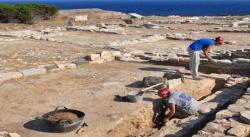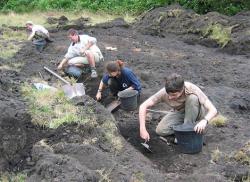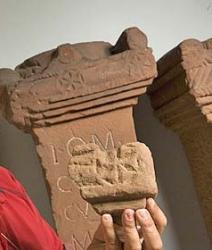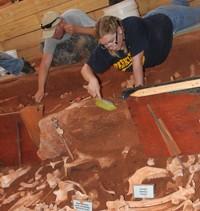- 19 JUILLET
- INDI-UNI : 
PRE-INSCRIPTION : 15 Juin – 15 Août
PRE-REGISTRATION: June 15th - August 15th
- GRECE –  Cyclades - On the small uninhabited island of the Cyclades, excavations which took place from June 2nd until July 8th, brought to light many important discoveries. The excavations were carried out with the sponsorship of the Latsis and Kanellopoulos Foundation. On another island, Despotiko in the region of Madras, a statue of a young man was discovered with his hand bent on his chest. In the area around the sanctuary, the upper part of a body representing a young man was also discovered. The sculpture has characteristics of the workshops of Paros of the end of the 6th century BC. His discovery will contribute to the study of many fragments which were discovered at the temple. It is possible that some sculptures are related to other fragments which had been discovered in former excavations in the area. In addition, many written findings of archaic and geometric ceramics reveal the existence of a sanctuary from the Geometric period. On the inhabited island of Tsimintiri, one of the five ancient buildings which date back to the 6th century BC was excavated. The rest of them will be studied thoroughly in 2012. A square marble cesspit used for rituals, the northern wall of the archaic building under constructions of the Late Byzantine Period and 6 new walls under the baths were also discovered.
Cyclades - On the small uninhabited island of the Cyclades, excavations which took place from June 2nd until July 8th, brought to light many important discoveries. The excavations were carried out with the sponsorship of the Latsis and Kanellopoulos Foundation. On another island, Despotiko in the region of Madras, a statue of a young man was discovered with his hand bent on his chest. In the area around the sanctuary, the upper part of a body representing a young man was also discovered. The sculpture has characteristics of the workshops of Paros of the end of the 6th century BC. His discovery will contribute to the study of many fragments which were discovered at the temple. It is possible that some sculptures are related to other fragments which had been discovered in former excavations in the area. In addition, many written findings of archaic and geometric ceramics reveal the existence of a sanctuary from the Geometric period. On the inhabited island of Tsimintiri, one of the five ancient buildings which date back to the 6th century BC was excavated. The rest of them will be studied thoroughly in 2012. A square marble cesspit used for rituals, the northern wall of the archaic building under constructions of the Late Byzantine Period and 6 new walls under the baths were also discovered.
http://greece.greekreporter.com/2011/07/19/important-archaeological-findings-discovered-on-islands/
- FRANCE –  Plesder - Depuis 12 ans, des opérations de prospection portant sur la paléométallurgie de fer sont conduites en Ille-et-Vilaine et dans les Côtes-d'Armor en liaison avec le centre régional d'archéologie d'Alet, l'unité de recherche de CNRS civilisation Atlantique et archéoscience et le centre d'Histoire des sciences et d'histoire des techniques de Paris-Sorbonne. Les sondages réalisés en 1999 et 2000 ont abouti à la découverte de bas fourneaux gaulois à Saint-Pierre-de-Plesguen, à Quévert et une installation gallo romaine dans la commune de Plesder. La première fouille, réalisée en 1999 dans des pâturages anciens de la commune, a permis la mise au jour d'un atelier de production datant du II e -III e siècle après JC. Pour Jean-Bernard Vivet, responsable du chantier, la fouille a permis de dévoiler le premier atelier de production massive de fer de ce type dans le Grand Ouest. « On a trouvé des rejets métallurgiques ferreux qui totalisent 600 tonnes. On a trouvé également du mobilier céramique aux abords du four, écuelle, mortiers... Aujourd'hui, nous avons une douzaine de ce type de fourneaux dans le nord de l'Ille et Vilaine. » L'objectif de ces nouvelles fouilles est de rechercher des éléments bâtis et des structures pouvant être liés à cette activité de métallurgie, afin de mieux connaître le type de production métallurgique et de découvrir la vie qui gravitait autour de ce bas fourneau.
Plesder - Depuis 12 ans, des opérations de prospection portant sur la paléométallurgie de fer sont conduites en Ille-et-Vilaine et dans les Côtes-d'Armor en liaison avec le centre régional d'archéologie d'Alet, l'unité de recherche de CNRS civilisation Atlantique et archéoscience et le centre d'Histoire des sciences et d'histoire des techniques de Paris-Sorbonne. Les sondages réalisés en 1999 et 2000 ont abouti à la découverte de bas fourneaux gaulois à Saint-Pierre-de-Plesguen, à Quévert et une installation gallo romaine dans la commune de Plesder. La première fouille, réalisée en 1999 dans des pâturages anciens de la commune, a permis la mise au jour d'un atelier de production datant du II e -III e siècle après JC. Pour Jean-Bernard Vivet, responsable du chantier, la fouille a permis de dévoiler le premier atelier de production massive de fer de ce type dans le Grand Ouest. « On a trouvé des rejets métallurgiques ferreux qui totalisent 600 tonnes. On a trouvé également du mobilier céramique aux abords du four, écuelle, mortiers... Aujourd'hui, nous avons une douzaine de ce type de fourneaux dans le nord de l'Ille et Vilaine. » L'objectif de ces nouvelles fouilles est de rechercher des éléments bâtis et des structures pouvant être liés à cette activité de métallurgie, afin de mieux connaître le type de production métallurgique et de découvrir la vie qui gravitait autour de ce bas fourneau.
http://www.ouest-france.fr/actu/actuLocale_-Ouverture-d-un-chantier-archeologique-dans-la-commune-_35225-avd-20110716-60911007_actuLocale.Htm
- AUSTRALIE – Hobart - Archeologists in Tasmania have found more than 300 convict-era artefacts under the floorboards of an old chapel. The discovery at Hobart's historic Penitentiary Chapel includes coins, clay pipes, home-made wooden gambling tokens, a writing slate and bones. Archeologist David Roe says it's particularly exciting because the artefacts are very personal items belonging to the prisoners.
http://www.abc.net.au/news/2011-07-19/20110719convict-past-unearthed/2801712
- FRANCE – Houat / Hoedic - Inauguration de la première exposition de l'Association Melvan. Une présentation d'envergure sur les fouilles archéologiques faites à Houat et Hoedic par Marthe et Saint-Just Péquart, de 1923 à 1934, qui font des deux îles des haut lieux de la préhistoire française. C'est d'abord dans les années 1923-1924 qu'avec Zacharie Le Rouzic, sur l'îlot Er Yoc'h (Mulon), qu'avait été découvert un site exceptionnel du néolithique récent. Dix ans plus tard, les chercheurs feront la découverte à Hoedic de deux nécropoles du mésolithique, environ 5 000 ans avant JC, contenant de superbes sépultures avec des squelettes parés d'ocres et de coquillages, le tout entouré de bois de cerfs. Des sépultures qui constituent les restes humains les plus anciens de Bretagne. L'exposition, présentée pour la première fois en 2007 à Hoedic, puis à Carnac, c'est à Houat, jusqu'au 15 août, qu'elle pourra être visitée.
http://www.ouest-france.fr/actu/actuLocale_-Houat-et-Hoedic-hauts-lieux-de-la-prehistoire-francaise-_56086-avd-20110716-60915712_actuLocale.Htm
- ROYAUME UNI –  Maryport - Archaeologists working on the monumental dig at Maryport in Cumbria say they have “comprehensively overturned” long-held theories that the altars found at the site in the 19th century were used in Roman religious and ritual burial ceremonies. Ten pits have been excavated in the six-week project. Masses of broken red sandstone and huge granite boulders have been found, as well as the bases of massive, rotted timber posts which left traces of green-stained sand. Among a series of new examples of the altars the area is best known for concealing, decorations featured a six-petalled rosette, a circle and a fragment from a stone dedicated by a Spaniard during the reign of Hadrian, completing an existing stone in the nearby Senhouse Roman Museum. Site Director Tony Wilmott and Professor Ian Haynes, the Excavation Director for the project, said that research on the fragments showed that they came from altars originally found in the 17th and 18th centuries, and were only used as packing material for the posts in the later burials. Six post-pits, discovered in a line, suggest a wall of a mystery building, and a curving group of four pits could indicate an adjacent development in the vicinity. “The altars excavated in 1870 are an internationally important find because of the information they provide about the lives of commanding officers in the Roman empire,” said Peter Greggains, the Chairman of the Senhouse Museum Trust. “Now we are beginning to see how the site here at Maryport developed too. The excavation has really brought the site to life.”
Maryport - Archaeologists working on the monumental dig at Maryport in Cumbria say they have “comprehensively overturned” long-held theories that the altars found at the site in the 19th century were used in Roman religious and ritual burial ceremonies. Ten pits have been excavated in the six-week project. Masses of broken red sandstone and huge granite boulders have been found, as well as the bases of massive, rotted timber posts which left traces of green-stained sand. Among a series of new examples of the altars the area is best known for concealing, decorations featured a six-petalled rosette, a circle and a fragment from a stone dedicated by a Spaniard during the reign of Hadrian, completing an existing stone in the nearby Senhouse Roman Museum. Site Director Tony Wilmott and Professor Ian Haynes, the Excavation Director for the project, said that research on the fragments showed that they came from altars originally found in the 17th and 18th centuries, and were only used as packing material for the posts in the later burials. Six post-pits, discovered in a line, suggest a wall of a mystery building, and a curving group of four pits could indicate an adjacent development in the vicinity. “The altars excavated in 1870 are an internationally important find because of the information they provide about the lives of commanding officers in the Roman empire,” said Peter Greggains, the Chairman of the Senhouse Museum Trust. “Now we are beginning to see how the site here at Maryport developed too. The excavation has really brought the site to life.”
http://www.culture24.org.uk/history+%26+heritage/archaeology/art360678
- USA –  Vore Buffalo Jump - Nearly a dozen students got their hands dirty at the Vore Buffalo Jump during a University of Wyoming Archaeology Field School. The students, along side professional archaeologists, participated in the dig near Beulah, Wyo. The six-week school sends students to several archeological sites including Pine Bluffs, Wyo., where students worked at the enormous site that extended for miles including teepee rings, shelter sites and early ranches. The school culminates with the buffalo jump. Over two years of excavations, Reher and the team dug down 25 feet before finally reaching the final layer of bones from buffalo estimated to have been killed around 1500. “Its just level after level. There are 22 levels here,” he said. About five American Indian tribes used the jump to kill thousands of buffalo from around 1500 to the 1800s. “In those 300 years, they killed 10,000 to 20,000 bison. They are stacked up like a giant layer cake,” Reher said. The buffalo jump is a large sinkhole, about 75 yards wide and 50 feet deep. American Indians would gently haze large herds of buffalo near the jump and then stampede them. In the bottom of the sinkhole, they are finding the remnants of the hunts. “Sixty to 80 percent of the long-limb bones are not there. They were taken from the site, broken and had the marrow extracted,” he said. “What's left down here are primarily backbones, ribs, lower feet, skulls, things that don't have a lot of meat on them. Scattered among them are butchering tools. Some were worn out, there are chips from them sharpening them and some were lost. There are a few arrow points.” Reher said the initial processing was at the jump but the vast majority was transported to a large village that was probably along Sand Creek, where the real butchering began. “You would have a huge butchering area, hundreds of drying racks covering acres, hundreds of hearths and smoking fires,” he said.
Vore Buffalo Jump - Nearly a dozen students got their hands dirty at the Vore Buffalo Jump during a University of Wyoming Archaeology Field School. The students, along side professional archaeologists, participated in the dig near Beulah, Wyo. The six-week school sends students to several archeological sites including Pine Bluffs, Wyo., where students worked at the enormous site that extended for miles including teepee rings, shelter sites and early ranches. The school culminates with the buffalo jump. Over two years of excavations, Reher and the team dug down 25 feet before finally reaching the final layer of bones from buffalo estimated to have been killed around 1500. “Its just level after level. There are 22 levels here,” he said. About five American Indian tribes used the jump to kill thousands of buffalo from around 1500 to the 1800s. “In those 300 years, they killed 10,000 to 20,000 bison. They are stacked up like a giant layer cake,” Reher said. The buffalo jump is a large sinkhole, about 75 yards wide and 50 feet deep. American Indians would gently haze large herds of buffalo near the jump and then stampede them. In the bottom of the sinkhole, they are finding the remnants of the hunts. “Sixty to 80 percent of the long-limb bones are not there. They were taken from the site, broken and had the marrow extracted,” he said. “What's left down here are primarily backbones, ribs, lower feet, skulls, things that don't have a lot of meat on them. Scattered among them are butchering tools. Some were worn out, there are chips from them sharpening them and some were lost. There are a few arrow points.” Reher said the initial processing was at the jump but the vast majority was transported to a large village that was probably along Sand Creek, where the real butchering began. “You would have a huge butchering area, hundreds of drying racks covering acres, hundreds of hearths and smoking fires,” he said.
http://www.bhpioneer.com/local_news/article_5e5f2506-b156-11e0-9517-001cc4c002e0.html
- ROYAUME UNI – Nairn - Archaeologists believe the remains of burned oak uncovered at the site of the first Sainsbury's in the Highlands to be evidence of an ancient "rest stop". They radiocarbon-dated the hearth to the Mesolithic period, which started as the last Ice Age ended about 12,000 years ago. The archaeologists said the fire appeared to have been made to provide heat and not cooking, because no food waste was found. They added: "The dating of a feature from charcoal is problematic since the wood that was being burned may have been felled a long time before it was used. "Activity in the area during the Mesolithic period is known from the discovery of a number of small flint tools along the Culbin Sands in Nairn. "The lack of any other Mesolithic dating on the site suggests that there was no settlement in the area, and that instead the hearth represents a temporary rest stop." Nomadic hunter-gatherers may have been attracted to nearby Culbin Sands because of its woodland wildlife, or to fish along its shoreline. During the Mesolithic period, Britain was transformed from a peninsula to an island. It is thought that landslides in Norway - the Storegga Slides - triggered a massive tsunami when a landlocked sea burst its banks. The water struck the north-east of Britain with such force it travelled 25 miles (40km) inland, covering low-lying plains in water or turning it into marshlands.
http://www.bbc.co.uk/news/uk-scotland-highlands-islands-14189794
- USA –  Champoeg - Oregon State University students, led by professor David Brauner, are conducting an archaeological dig of the remains of Robert Newell's farmstead at Champoeg State Heritage Area. The site dates from about 1831 to around 1861. Newell was one of the founders of the town of Champoeg and very important in early Oregon government.
Champoeg - Oregon State University students, led by professor David Brauner, are conducting an archaeological dig of the remains of Robert Newell's farmstead at Champoeg State Heritage Area. The site dates from about 1831 to around 1861. Newell was one of the founders of the town of Champoeg and very important in early Oregon government.
http://www.statesmanjournal.com/article/20110716/LIFE/107160307/Outdoor-Adventure-Champoeg-finds?odyssey=nav|head